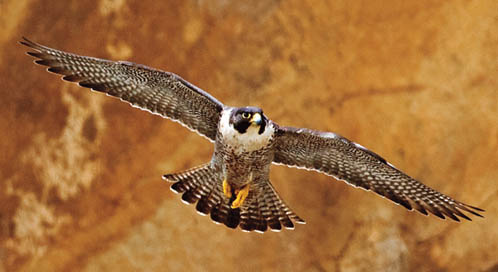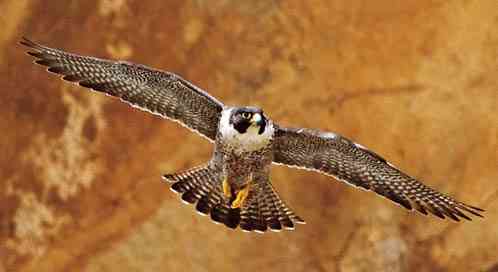America’s rich wildlife heritage exists today, thanks—in no small way—to the ESA
By Jamie Rappaport Clark

© Flickr user KevinCole
I was hot, sweaty and itchy from bug bites, but I was exactly where I wanted to be: in the untrammeled remote reaches at of Aberdeen Proving Ground in Maryland, entrusted with the lives of five endangered peregrine falcon fledglings.
A 20-year-old college student in 1978, I felt lucky that The Peregrine Fund had chosen me to spend the summer as a hack site attendant—a falconry term for someone who feeds, waters and protects the birds before they fly off into the wild. That summer provided me an opportunity to participate in a remarkable recovery effort.
Back then, peregrine falcons sat on the edge of extinction, compromised by DDT. The pesticide—banned in 1972—accumulates in tissues and interferes with eggshell formation. Falcons were laying eggs with such thin shells they often broke during incubation or otherwise failed to hatch. To help them recover, biologists began breeding the falcon in captivity and releasing them in the wild in 1974.
I placed my fledglings in a special cage at the top of a wooden tower to acclimate them to their new home, and, one by one in the coming weeks, the chicks learned to hunt and fly on their own. By the end of summer, when the last falcon had spread her wings and left the hack site area for good, I felt a sense of pride, as much for them as for myself.
It was hard to see them go. But at the same time, I knew that we were part of something bigger. Those chicks would someday raise chicks of their own in the wild without help from any human and the cycle of life—and recovery—would continue.
As the director of the U.S. Fish and Wildlife Service 20 years later—in a full circle of my own—I had the honor to join representatives of The Peregrine Fund and other raptor conservationists to announce the full recovery of the peregrine, which was removed from the endangered species list in 1999.
The recovery of the peregrine is an endangered species success story, but it’s not the only one. Spectacular recovery efforts are happening every day all across the country—because of the Endangered Species Act (ESA), which celebrates its 40th anniversary this year. As the strongest federal environmental law on our books, the ESA not only provides the means to prevent extinction and to steadily improve the future of seriously imperiled plants and animals, it also protects the ecosystems on which they depend.
Many endangered species contribute to the maintenance of vital ecological services. For instance, mussels help to purify our water, while wolves have brought balance back to western ecosystems by reducing elk browsing pressure on streamside vegetation. This allows aspen and willow to grow and provides healthy habitat for birds, beavers, fish, frogs and others to live. Other protected species produce beneficial medicines and are the basis of booming wildlife-related recreation and tourism. And then there are many other listed species, whose ecological or economic contributions are not yet fully appreciated or understood.
In 1973, when the federal government enacted the ESA, numerous wildlife species—from the peregrine and the bald eagle to the grizzly and the wolf—were in dire straits. Without the ESA, our country would look a lot different today. Bald eagles would not fly along our shorelines, peregrine falcons would likely have vanished, grizzly bears and wolves would no longer roam western landscapes, bull trout would no longer swim in our streams and black-footed ferrets would have disappeared from the prairies.
Thanks to the ESA, people gather in places like Sauk City, Wisconsin, to see bald eagles on the banks of the Mississippi River in winter, wildlife lovers thrill at sea otters frolicking off the coast of California, and tourists in Massachusetts head off in boats to track protected whales migrating through Atlantic waters.
But many species still need our help as they face the extreme challenges of accelerating climate change, invasive species, habitat destruction and development, and intense pressures to increase energy production. Another big threat comes from anti-environmental politicians who want to dismantle the ESA.
Stewardship didn’t use to be a political issue. It was an American value and deeply felt commitment. In fact, Congress nearly unanimously passed the original ESA in 1973, and President Richard Nixon signed it into law. We need that bipartisan conservation spirit again. Protecting species for their intrinsic value and their value to future generations of Americans is as important now as it was four decades ago. Wildlife still holds the key to solutions for challenges we have not yet begun to imagine. We must uphold the conservation values and sense of responsibility to future generations that shaped the ESA.
After all, we are all linked in this world. Like fish, we all need clean streams. Like birds, we need clean air. And like every species, we need ecosystems that support life on Earth.

